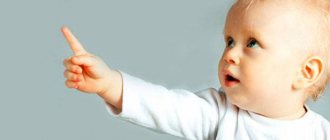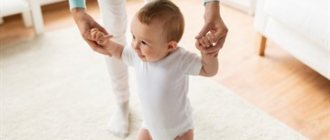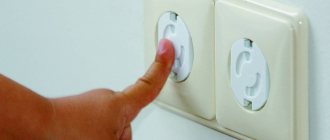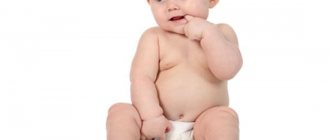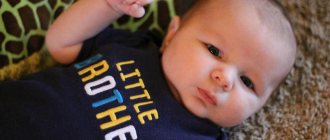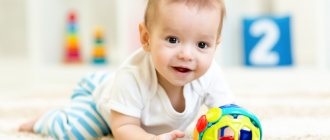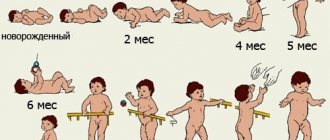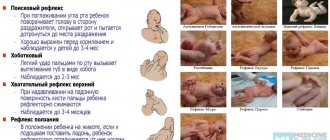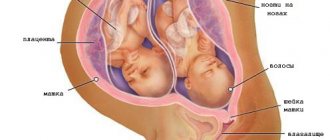Logic and mathematics - what to develop?
1. Learn the concept of “many - little”.
2. Closer to three years - master the concept of “more-less” (determine the number of objects in a group - which ones are more and which ones are smaller).
3. Learn to distinguish between the number of objects “one” and “two”. (At a minimum. You can go further, learn to count to 3 - 4, but not all children aged 2 to 3 can do this - take into account the child’s interest and his abilities).
4.Learn to sort objects - by size, by color, by type (sort different types of pasta, buttons, large and small objects (circles, squares, etc.)), try other types of sorting.
5. Learn to navigate in space (learn the concepts of higher, lower, right, left).
6. Fold yourself, without the help of your mother, elementary puzzles or cut-out pictures from 2-3-4 parts (this skill develops gradually and becomes more developed closer to three years; at first, the mother helps the child).
7. Learn to match - play “who eats what”, “where is whose house”, “where is whose tail” (with cards or in pictures in books and manuals).
8. Play riddles - the mother describes an object or animal in the simplest form, the child guesses it from the description (for example - small, fluffy, with long white ears, jumps like that and eats carrots, who is it? Who says “moo-moo” and gives milk? Etc. Gradually you can complicate the riddles).
9. Guess the animal from the description.
10. Stack several nesting dolls and cups into each other.
11. Build a tower from cubes/cups with decreasing size:
12. Learn to compare figures, geometric bodies with their projections (Dyenesha blocks, homemade preparations):
13. Closer to three years - designing simple structures according to the drawing (approximately like in the picture, but it’s better to start with two parts):
14. Starting from 2.5 years old, play Nikitin’s “Fold the Square” (at first, together with the child, but very quickly children learn to assemble it on their own):
15. Starting from 2.5 years old - play prefabricated puzzles:
16. Learn to classify objects according to a general characteristic (for example: cards with images of toys, food, animals are laid out in front of the child. The child is asked to arrange them into appropriate groups (for example, toys in a box, food in a “refrigerator”, animals in a “house”). At first, the child learns to arrange objects with the active help of his mother.For the learning to be successful, it is better to play for a long time with the same set of objects (for example, to begin with, for a long time sorting cards of only toys and food).
Cards or wooden “Pick a Group” toys are great for mastering this skill:
17. Classification of objects - play the game “what’s in this room?” (find what is round in this room? What is soft in this room, etc.).
18. Games with Dienesh blocks, with a simple construction set, and other suitable items (toys, pasta, buttons, beads, etc.) by type:
- find objects, figures of the same shape;
- find objects, figures of the same color;
- find objects, figures of the same size;
- find the same figures by size, thickness and other characteristics.
19. Games with Cuisenaire sticks.
20. Play “part and whole” - “whose tail is this”, “match the roof to the house”, etc.
21. Learn to find a figure based on two signs (for example, find a large yellow circle (in a group of objects there is also a small yellow circle and circles of other colors), a small red square, etc.).
22. Closer to three years (and very individually) - find mistakes in pictures (working with manuals) - what is missing, what is wrong, which of the objects is the wrong color, etc. The very inexpensive manuals from the “Smart Books” series are great for this:
Child development at 19 – 21 months
Child development at 1 year 7 months – 1 year 9 months
Runs quite quickly and freely.
With one hand resting on the hand of an adult or grabbing the railing with one hand, he goes up and down the stairs, placing two feet on each step (Fig. 47). Throws the ball down, forward, up. Easily climbs onto the sofa, chair, and goes down to the floor. Can pick up objects from the floor without falling.
Eats any food independently, including liquid food from a plate, with a spoon. Independence is not yet accompanied by neatness, although to a lesser extent he gets dirty around himself while eating. Can also use a fork well.
Despite the fact that the quantity and quality of everyday skills is increasing, the set of acquired skills is individual. Basically, children at this age know where to store clothes, toys, books and other things. So they can take things and put them back. There is a desire to do a lot on your own.
The skills of removing clothes are improving - he takes off one or two items of clothing: not only a hat and unbuttoned shoes, but also an unbuttoned jacket, and sometimes underwear.
Some children at this age can put on socks, shoes or a hat on their own. There are also children who are able to unfasten 2-3 large buttons located on places of clothing that are convenient for manipulating with their hands.
Continue teaching your baby hygiene skills. During this period, almost every child washes and wipes his hands on his own with a towel. True, he still can’t use soap. Gradually teach your child to brush his teeth in a playful way.
Don't miss the moment when your child starts asking to go to the potty. But keep in mind that you need to wean your baby off diapers when he begins to demonstrate the urge to urinate through gestures, posture or sounds. Until such signs appear, various methods of training to independently urinate are ineffective.
Tries to help adults around the house. Must be able to imitate his mother and perform simple everyday activities.
Games
Builds a tower of four to five cubes. Assembles a pyramid of three to five rings without taking into account their size. You can teach how to assemble a pyramid according to size. Show your child a correctly assembled pyramid of two and then three rings and ask him to make the same one. Tell your child that rings come in different sizes and show him two rings - a large one and a small one. Say: “Let’s put on the big ring first, and then the small one.” For a few minutes, refrain from prompting and watch your baby work independently. If all attempts are unsuccessful, then help the child: “You see, it didn’t work, don’t forget that you need to take the largest ring first, then the smaller one.”
When playing with special sets, he begins to navigate in three contrasting shapes: ball, cube, brick. From objects of different shapes, according to the sample you offer (for example, a cube) and at your request, he will select an object of the same shape (cube). If the child does not immediately pick up a cube for you, then you can offer a task in a playful form: put a cube in front of the child, name it and invite the child to find more cubes to build a house out of them. If the child does not complete your task even then, then you need to demonstrate to him the completion of the task - place the second cube on the first, then remove the cubes, put one cube in front of him again and offer to complete the task.
The ability to play with geometric shapes is being improved. When playing, he collects, putting smaller ones into larger ones, nesting dolls, bowls, molds, caps, and plastic cups. Most children at this age can, at your request or independently during play, put three identical objects of different sizes into each other. Assembles a matryoshka doll from two parts.
When playing with inserts, he will correctly insert 1–2 (sometimes more) geometric shapes into the corresponding holes. However, hand-eye coordination is still underdeveloped. Therefore, when a new manual appears, it takes a long time to figure out how to insert the figure into the groove. Or, on the contrary, without thinking, he tries to force it in, without taking into account the shape and relative position of the edges of objects.
At 1.5–2 years old, it is advisable for a child to buy two types of board games: cut-out lotto cards with large bright designs and large mosaics with geometric details in all primary colors. Games of this type teach the child to classify objects according to various criteria: color, shape, size.
Children's games increasingly include elements of constructive creativity. A child aged 1 year 9 months, for example, can reproduce (after showing an adult) several simple plot buildings from wooden cubes: a train (3-4 cubes placed next to each other) or a turret (house) of three or four cubes placed on top of each other .
Performs different actions with one familiar figurative toy (doll, teddy bear): feeds, wipes, combs hair - including during independent play, if a play situation is created. Along with the skill of performing one action with different toys, the child also masters performing different actions on one toy: driving, feeding, putting the bear to sleep.
Able to master a long series of game actions, and not just roll a toy car back and forth. Some children can be taught to put toys in the back of the car, drive the car to another part of the room and unload them there. Or put your favorite bear cub in the back of a toy truck and take him, say, to the kitchen. Thus, the game develops its own plot (story game).
In story-based play, the child easily replaces a real object with another or even assumes the presence of a missing object. So, the baby carries a cube instead of a car, imitating the sound of a motor, feeds his mother non-existent porridge, etc.
Independent play actions are accompanied by emotionally expressive statements and facial expressions. Receives emotional satisfaction from activities with toys.
If given a pencil, he diligently scribbles within the paper. If he already has the skill of holding a pencil, then after demonstrating to an adult how this is done, he can repeat the line you drew.
He likes to look at a book with pictures himself, turns the pages of the book one at a time, and not several pages at a time, as before.
Accurately follows two-step instructions (go to the kitchen and bring a cup), requiring two sequential actions in two different directions of movement: first, go to the kitchen and, second, bring a cup. Follows this purely verbal instruction without the help of auxiliary gestures and pointing actions on the part of an adult. Begins to carry out orders (instructions), which already consist of three stages. For example, he carries out an order: take a cup, go to the kitchen and put it on the table. In this case, the child needs to perform three sequential actions: firstly, take the cup, secondly, go to the kitchen and, thirdly, put the cup on the table.
Understands the meaning of the word “big.” Of two identical objects of different sizes, he will give you the larger one at your request.
Must be able to show 3-4 parts of the body or face that are called to him.
If you put several pictures in front of a child with objects and animals known to him, then to the adult’s question “Where is the cat?”, and then to the question: “Where is the dog?” etc. most children choose the pictures correctly.
Understands a simple story from an adult based on a picture with a simple plot. For example, “the boy is watering the horse” or “the children are washing themselves,” “the children are watering the flowers,” “the uncle is repairing the car.” After the story, pointing to the details of the pictures, get the child to answer the questions: “Who is that in the picture? What is he doing?" If he doesn’t answer right away, then ask questions with the prompt: “What is the boy doing? What is the horse doing?
A sharp growth in a child’s active vocabulary occurs between the ages of 1.5 and 2 years. New words appear every day. The active vocabulary has at least 20 words by 1 year 8 months, and many children have much more.
Begins to pronounce two-word sentences (simple phrases), girls - usually from the age of one and a half years, boys - closer to two years. Phrasal speech occurs and is primarily used to ask questions and express simple needs. He asks adults to give him some object, and also asks to drink and eat, no longer with gestures, but with words: “give me a drink,” “I want to sit down,” “I want to poop,” “let’s go for a walk,” etc. First phrases narrative type most often consist of a noun and a verb: “dad is coming”, “the doll has fallen”. Later, adjectives are added to them: “big”, “small”, “good”, etc.
He begins to combine words: “uncle’s hat.” From an attentive listener, the child turns into a real interlocutor.
However, along with the correct words, the child continues to use simplified words, even in phrasal speech. For example: “Papa, di” (dad, go). “Ma, yes kh” (Mom, give me some kitty). Due to the lack of words, the child may accompany his verbal communication with gestures.
Bitterlich L.R. Your child from birth to 6 years old.
Source: Child development at 19 – 21 months Child development at 1 year 7 months – 1 year 9 months Runs quite quickly and freely. With support with one hand on the hand of an adult or grabbing the railing with one hand, he rises and descends https://olymp.com.ru/razvitie-rebjonka-v-19-21-mesjatsev
Development of attention.
1. Play “Find it!” - we ask the child to find an object in the room (find where your teddy bear is, where the red cube is), on the street (look through the window - find where the dog is walking? Find the red car!), search in a picture in a book, etc. .P. – you can play anytime, anywhere. This game is very simple, children are easily drawn into it. At the same time, attention and the ability to concentrate it develop very well.
2. The game “Find a Pair” is a more complicated version than it was for a year or two - find a pair among objects that are very similar to each other. For example:
3. Find the same pattern (pairs of mittens, hats, cups and saucers, patches for towels, roofs for houses, etc.):
4. Closer to three years - build a turret, a house according to the drawing (you need to start with 2 parts).
5. Games with Dienesh blocks, Cuisenaire sticks.
6. Search for objects based on one characteristic - find what is red, hard, soft, round, large, etc. in this room. (you can play anywhere).
7. Search for objects based on two characteristics - find what is large and white, small and hard, etc. in this room.
8. Play hide and seek with the child (hide so that the baby can easily find it, prompt the child by calling him with your voice).
Physical development of the child:
- Not only walks, but also runs well.
- He stumbles less and less often because he looks at his feet as he runs.
- Runs around small objects that it encounters on its way.
- Climbs stairs without assistance (while standing on each step with both feet).
- It is still difficult for him to go down the stairs without outside help.
- Can squat.
- Jumps not only in place, but also forward.
- Able to get out of the playpen.
- Opens the door to the room.
- He kicks the ball, almost missing.
- Throws the ball up.
How to develop memory.
1. “What’s missing?” - remember the pictures (toys) laid out on the table, guess which picture mom hid. Memorizing objects is carried out in a playful way - the mother tells a fairy tale about objects that are laid out on the table; during the process of the fairy tale, the child manages to remember its characters well. After this, mom takes one of them and asks “who is missing?” You can read more about how to play this game with very young children here.
2. What appeared? – we play according to the same principle as written in the previous paragraph, but we do not hide, but add toys, the child must determine which toy the mother added.
3. Hide 3-4 toys with the child. Then ask him to find them (we search from memory).
4. Ask the child to bring 2-3 items (we bring items from memory).
5. Together with the mother, remember what the child did yesterday, in the morning, some time ago, what events happened on the street (which friends were out today, what toys they had, etc.).
6. Remember what is drawn in the picture and answer questions about what was drawn there after the picture is closed.
7. Game “Find a Pair” with hide and seek – the mother shows the child a picture and hides it behind her back. Asks to find the same picture in a group of cards (the child looks for a paired picture not holding it in his hand, as usual, but from memory):
8. Game of “thimbles”. We take multi-colored cups and put a toy under one of them. We swap the cups several times, then ask them to find where the toy is hidden (we gradually increase the number of toys and cups).
9. “Memory” - a game with 2-3 cards. We put cards in front of the child, the child remembers them (to help him, you can tell a fairy tale about the heroes who are drawn in the pictures; while listening to the fairy tale, the child will remember the location of the cards well. The “fairy tale” can be very simple from 4-5 sentences). We turn the cards picture side down - this way, all the pictures are hidden from the baby and are not visible to him. We ask the child to find where a certain card is located from memory (“find which card has a bear on it?”). Another version of "Memory" can be found here.
Physical development.
1. Jump in place on two legs. Closer to three years - learn to jump forward (but not everyone succeeds in this).
2. Learn to throw and catch a ball, throw a ball against a wall.
3. Throw up a balloon or ball.
4. Maintain balance while walking along a board placed on the floor, along a bench, or a beam.
5. Depict animal movements as shown by mother.
6. Crawl (like a boa constrictor, like a caterpillar) on your stomach forward.
7. Jump like a bunny.
8. Pretend to be a bird - wave your arms while running around the room, squat - “look for grains in the grass”, jump - “fly up”.
9. Stomp loudly, raising your legs high, like an elephant.
10. Swim like an octopus: lie on your back, raise your arms and legs up, wave your arms and legs (“swim”).
11. Run fast, slow, on your toes.
12. Sitting on the floor, knock on the floor with your feet, “like a drum.”
13. Roll on the floor like a bun.
14. Jump from a half-squat like a frog.
15. Dance and practice logorhythmics (to the music of the Zheleznovs and other authors).
16. Lift objects from the floor by bending or squatting.
17. Reach your arms up, reaching for objects that are located high (the mother can hold objects at the height of the child’s outstretched arm).
18. Move around the room without touching objects scattered on the floor (for example, pillows), gradually increasing the pace and number of objects.
19. Carry large, but not heavy things (for example, a highchair, a light box of toys).
20. Walking on massage surfaces.
21. Walking on tiptoes, closer to three years - on heels.
22. Perform dance movements - place the foot on the toe, on the heel.
23. Walking along a winding line drawn on the floor (or a strip of paper) - development of coordination.
24. Crawling under a tight rope.
25. Game “Catch a sunny bunny” - we play with a sunny bunny that mom lets out.
26. Collective games: dance in a circle, run like a train after each other (children hold on to each other), games with a special children’s play parachute, games of “catch up”, “wolf and bunnies”, etc.
27. "Cat and mouse." While the cat is sleeping (an imaginary cat or another adult), the children and mother walk quietly. When the cat wakes up, they quickly run into the house.
28. Hanging on the horizontal bar, rings, mother’s hands.
29. Climb on sports walls at home, on playgrounds.
30. Walking on “bumps” (chaotically scattered pillows, books).
31. Climb through a tunnel (purchased or built from chairs placed in a row).
32. Fitball games.
33. Game “Snail and House”. The child gets on all fours. A pillow is placed on his back. He turns into a snail, which carries its house (pad) on its back. The snail's task is to go as far as possible without dropping its house (we crawl on all fours, carrying a pillow on our back).
34. Walking on your hands:
Music and rhythm.
1. Listen to a lot of songs according to age.
2. Learn to listen to music - while listening to classical melodies with your mother, listen to your mother’s story “What does this melody tell us?” It’s easy to come up with such a story yourself (for example, like this), with its help the child develops the ability to truly listen to music, to capture its shades and mood.
3. Learn to distinguish between fast and slow music, learn to play noise musical instruments quickly and slowly.
4. Learn to distinguish between happy and sad music.
5. Learn to distinguish between loud and quiet music, learn to play noise musical instruments loudly and quietly.
6. If there is an opportunity (large family) to play the game “who called?” (the child guesses by voice who is calling him).
7. Listen with your mother to the “sounds of life” - birds chirping, a car making noise, leaves rustling, etc.
8. Try to determine where the sound is coming from (for example, “do you hear a bird chirping? What tree do you think it’s sitting on?”).
9. Practice logorhythmics (to the music of the Zheleznovs and other authors).
10. Play musical instruments (children's and noise instruments - drum, maracas, tambourine, xylophone, etc.).
11. Get acquainted with various instruments and their sounds (you can watch videos on YouTube with your child, where performers play classical music on various instruments).
12. Closer to three years (if the child is fond of songs and remembers many melodies by ear) - play guess the melody - the mother sings the melody (“A Christmas tree was born in the forest”, “Antoshka”), the baby guesses what kind of song it is.
13. Sing songs to your child.
14. Dancing - quickly, slowly, stamping your feet, clapping your hands, twirling your palms - the "flashlight" movement, jumping, putting your feet on your toes - on your heels when dancing, tapping your heel on the floor, tapping your toes on the floor, doing a round dance, dancing with objects – spoons (we dance and knock spoons on the floor, against each other, over our heads, behind our backs, loudly-quietly, quickly slowly), maracas rattles (we dance and accompany ourselves, perform the same movements as with spoons), with handkerchiefs ( alone and in pairs with mom.)
15. Encourage independent performance of dance movements to dance tunes. Intensify the performance of movements accompanied by music that convey the character of the animals depicted.
Drawing.
1. Draw paths.
2. Draw circles.
3. Draw simple compositions - rain, snow, grass, Christmas tree decorations on the tree, circles (which will be balls, apples, etc.), draw sticks - strings for balls, stems (sticks) for flowers, handles for shoulder blades, hedgehog needles, grass, patterns (random) on cups, rugs, towels.
4. Draw vertical and horizontal lines.
5. Draw short and long lines.
6. Closer to three years - color pictures (some drawing teachers are against coloring - they believe that coloring kills creativity (since the child does not draw on his own, but works according to a ready-made template). Decide individually whether to teach your child to color or not).
7. Draw the child’s attention to the choice of color for the drawing (we draw the grass in green, the rays of the sun in yellow).
8. Draw with a stick on sand, semolina, snow.
9. Leave prints with paints using stamps and sponges.
10. Learn to paint with paints (wash and wet the brush).
11. Paint with finger paints.
Modeling.
1. Roll out plasticine and dough with straight and circular movements of your hands (balls and sausages).
2. Break off small lumps from a large lump, flatten them with your palms and fingers.
3. Connect the ends of the rolled stick, pressing them tightly against each other.
4. Just play with dough and plasticine (free creativity).
5. Sculpt lumps of plasticine onto paper (feed the chicken, make dots for the ladybug, etc.).
6. Master the technique of smearing plasticine on paper.
7. Leave imprints on the dough with various objects.
8. Cut out shapes from the dough using cookie cutters.
9. Learn to cut dough with a plastic knife.
The world.
1. Continue studying domestic and wild animals and their young. Learn simple facts about animals (where they live, what they eat, characteristic features, for example, “a cow gives milk”, “a goat butts”, etc.), learn what pets give to a person, learn the names of the main parts of an animal’s body (horns) , hooves, etc.).
2. Birds - expand your knowledge about bird species, study basic facts about birds (where they live, what they eat, how offspring appear, names of chicks). Gets acquainted with the division into domestic and wild birds (just talk through this with the child, when studying birds, emphasize that someone lives next to a person and benefits him, someone is a wild bird and lives on its own).
3. Insects – study the most common insects (ant, bee, butterfly, etc.); know the simplest facts from their life (a bee brings honey, a caterpillar gnaws on leaves, etc.), recognize them by their appearance, and cultivate a kind attitude towards insects. Bring to the understanding that all insects are alive: they breathe, move, feed.
4. Get acquainted with the concept of day and night. Try to distinguish between morning, lunch, evening.
5. Get acquainted with natural phenomena: rain, snow, wind, rainbows.
6. Get acquainted with 3-4 trees and flowers that are most characteristic of the area.
7. Fruits, vegetables, berries, mushrooms: have an idea, know the names of the most common ones in everyday life.
8. Seasons: get acquainted with the signs, read fairy tales and poems dedicated to each season (the average child will be able to “get acquainted” with the concept, clearly draw boundaries between different seasons after 3 years). An example of educational activities on this topic can be found here: spring 1, spring_2, winter, autumn.
9. Gets acquainted with the concept of the materials from which surrounding objects are made (paper, wood, stone, glass).
10. Explore topics:
- Transport.
- Doctor, clinic.
- Shop.
- Family.
- The world of the sea (inhabitants, sea elements, ships).
- Train and railway, rails, carriages, driver.
- Fish, aquarium, underwater world. (Observe the fish, note their features (“Has a tail, eyes, mouth, lives in water”).
- City.
11. Adult labor. Learn to distinguish between some labor actions. Foster a sense of respect for the work of mother and other people.
12. Generalization of the topic “Man” - structure, parts of the body (if parents wish - basic knowledge about internal organs), health, conversation about the need for hygiene.
13. Household appliances, electrical appliances. Safety rules for handling electricity (sockets, plugs of electrical appliances).
14. Professions. (At this age, it is better to study professions without interruption from the general topic. For example, we study the topic “transport” - along the way we study the professions of driver, pilot, etc. We study the topic “doctor, health” - we study the profession of doctor, nurse, etc.) .
15. If at the age of 2 to 3 you plan to send your child to kindergarten, pay attention to introducing the child to the theme of kindergarten, talk and play through the most important points - independence, parting and meeting with mother, independent sleep, routine, respect for teachers, etc. .P.
A child at 2 years old: what is he like?
Children 2–3 years old are very active. They can’t sit still, and they want to find out how this world works, try everything and go everywhere. But, despite this, children at this age are more attentive than at one or one and a half years.
At 2 years old, children absorb as much information as possible, so it is imperative to develop them. At the same time, it is not at all necessary to buy expensive toys and take them to special classes. It is enough just to follow the interests of your child and try to answer all his questions and explain everything that is happening. However, don't overdo it. The baby may get tired of receiving new knowledge and refuse to accept the information.
In order for a child to complete developmental tasks, he must be interested in them. It is quite difficult to achieve this, so parents often send their children to educational preschool institutions, where specialists are involved in developing the child’s abilities.
Development while walking.
1. Traffic rules: introduce the child to the rules for crossing the road, explain the dangers of inattentive behavior on the road. Explain that the sidewalk is for people, the road is for cars. Discuss the rules for safe crossing of the roadway (traffic lights, zebra crossings). To develop children's powers of observation and the ability to correctly assess traffic on the road (learn to check whether it is possible to cross the road, evaluate how cars are moving - fast or slow, explain that we cross the road only when there are no cars or they are far away). Learn to cross the road only with an adult, and not to run out onto the roadway.
2. Learn to navigate in space (study the use of words such as “there”, “here”, “here”, “there”, “right”, “left”, “far”, “close”, “near”), study prepositions of place.
3. In the house on the playground, play simple fairy tales in which there is a house: “Zayushkina’s Hut”, “Teremok”, “The Wolf and the Seven Little Goats”. Encourage the child to tell a fairy tale together with an adult (finish sentences, insert familiar words), to depict and pronounce the lines of the fairy tale characters in a simple form (to be a bunny, a mouse, etc.). Play how best to greet dad in the evening when he returns from work (or another loved one), what to say to him.
4. Study vegetation - flowers, trees, grass, bushes (names and differences). Learn to distinguish between a tree and a bush. Study parts of plants (leaf, trunk, etc.). Monitor seasonal changes in nature (yellow leaves, fallen leaves, bare trees, buds appearing, etc.). Teach respect for plants. Water trees and flowers from a watering can.
5. Using the example of trees, grass, bushes, twigs, study the concepts of “thick-thin”, “big-small”, “many-little”, “high-low”.
6. Transport: distinguish between types of transport, distinguish between types (truck, passenger) and parts of the car (cabin, steering wheel, wheel).
7. In a relaxed manner, encourage the child to answer the question: “What is this?” a sentence consisting of several words (for children who have already begun to actively master phrasal speech).
8. Sunshine: talk about the fact that life on earth requires the sun, that the sun helps plants grow, warms all living things on earth. Watch the sun (hidden behind the clouds, bright, dim, setting, rising, sunset).
9. Sky: observe changes in the sky - clouds, cloudy, cloudy, clear, gloomy, clear, sky at night.
10. Watch the moon.
11. Answer the questions: What did the clouds do? (They covered the sun.) What does the sun do? (Shines.) etc.
12. Using natural materials (pebbles, twigs) and objects of the surrounding world (trees, cars, etc.) study the concepts of “thick-thin”, “big-small”, “many-little”, “high-low”, “hard-soft”, “warm-cold”, “most” (“highest, lowest”), colors, properties of objects, etc.
13. Develop vocabulary - discuss various objects encountered on the street (animals, birds, plants, people, transport, buildings, entrance, elevator, etc.). Name the qualities of these objects, tell why they are needed.
14. Discuss the need to maintain cleanliness on the street, in the entrance, respect for the environment and the cleanliness of the yard, street, entrance.
15. Play with sand. Pay attention to the properties of sand: dry, crumbles; if you water it (or after rain) it becomes moist, and you can make “pies” from it.
16. Play with snow.
17. Play with puddles (throw pebbles, cover with sand, dig, play with water, build canals, launch boats, study the properties of objects “sinking or not sinking”) - at the request of the parents.
18. Let the sunbeam, catch it.
19. Seasons: talk about changes in nature, changes in the lives of people, animals, birds.
20. Houses: clarify the names of different houses and buildings, study parts of the house (window, entrance, etc.).
21. Speak on the street various speech topics that are interesting to the child (animals, birds, babies, etc.).
22. In your free time from games, learn poetry.
23. Builders and workers: if possible, observe the work of adults on construction sites, workers of various services. Name and discuss their work activities, learn the names of professions, discuss the importance of their work, consider and remember the names of their equipment and tools.
Features of age
In order to choose the right educational games for a child 2–3 years old, you need to understand his age characteristics:
- Closer to 2 years, the child begins to perform certain movements more accurately, and his coordination improves. As a result of this, it becomes much more interesting for him to play with a sorter, construction set, puzzle or any other similar toy.
- Classes for 2-year-old children to develop logic are beginning to bring more success. This is due to the fact that at this age the baby begins to independently become interested in how to solve a particular problem or understand how and why a certain object works.
- Active games begin to interest the baby even more. Now he can better navigate in space, control the speed and direction of his movements.
- He has a small vocabulary that allows him to communicate with adults, describe what he sees, and also write simple sentences.
- Every month the baby becomes more and more independent, and he no longer needs as much of your attention, which means that at two and a half years old he can play educational games on his own.
Speech development.
All of the development methods given below are suitable for children who have already begun to speak individual words (even if in their own “children’s” language - this is a normal stage of development that most children go through). If your child is not yet in a hurry to talk, you may be better off using the speech development techniques that are published here.
Speech development in children aged 2 to 3 years:
1. Develop the ability to answer an adult’s questions about what is shown in the picture (in a very simplified form), about what is happening around – at home, on the street.
2. Communicate a lot with the child about all the situations and events that happen in his life (replenish passive vocabulary).
3. Read books, poems (if the child does not like reading, parents can compensate for this with active communication in everyday life (the previous point is about this), tell fairy tales and sing songs.
4. After reading books, discuss what you read with your child at the simplest level.
5. Together tell fairy tales familiar to the child (“once upon a time there was a grandfather... and who else lived? That’s right! Baba! Who did they have? Who says co-ko? That’s right! Well done! Chicken Ryaba!”).
6. Act out simple fairy tales with the child (for example, “Teremok” - the child can be a mouse sitting in a house and letting in the rest of the animals). As the game progresses, encourage the child to perform various actions (open and close the door, wave a hand in greeting and farewell, say simple words and phrases or onomatopoeia (“pee-pee!”, “ko-ko”).
7. Listen to songs.
8. Learn adjectives: use them often in conversation with your child, describing objects. Play the game "which one?" (ask the question “what is he like?” in relation to subjects that the child is interested in, answer this question, encourage the child to come up with the answer himself (if the baby remembers at least one adjective, that’s good!).
9. Study various prepositions (near, at, behind, etc.) and adverbs used for orientation in space (far, close, above, below, right, left, etc.), pronouns (there, here) , words for comparison (same, different).
10. When studying various lexical topics, pay attention to what parts objects and items consist of (for example, a house consists of a roof, a window, doors, etc.).
How speech develops from 2 to 3 years
At 2 years old, a child increases his vocabulary to 200–400 words and begins to construct phrases from 2–3 simple words or syllables.
- Most of the words used are nouns denoting objects and people from the immediate environment.
- Gradually, pronouns (“you”, “he”) and adjectives (“good”, “beautiful”) begin to appear.
- Asks questions related to the place of action: “where?”, “where to?”, “from where?”.
- Imitates the cries of animals and birds, imitates familiar sounds (car horn, special vehicle siren, steam locomotive whistle).
- Understands commands of 2–3 sequential actions (“Take a pencil and draw a sun”).
- May have problems with articulation: he does not pronounce all sounds, confuses syllables.
By the age of 3, the baby increases his vocabulary to 1200 - 1300 units, constructs phrases from 4 - 5 words, while complex words can still be shortened or replaced with simpler ones.
- In the absence of real speech therapy problems, he clearly pronounces almost all sounds, but some are still incorrect: [r], [l], whistling, hissing (it makes sense to contact a speech therapist if you have difficulties with these sounds no earlier than 4–5 years).
- Understands commands of 4–5 actions (“Go to your room, find a bear, bring it here and plant it next to us”).
Since a child’s hearing at this age is better developed than speech, he can easily miss his own articulation errors, but notice them in others. Take into account this feature of auditory perception and use it in communication with your baby, ensuring that you produce the correct sound pronunciation, because the child will copy your speech.
- Knows his first and last name, names the names of his parents, close relatives and friends; uses almost all parts of speech; changes words by numbers and cases; tells fairy tales, stories about events from his life, correctly repeats words and phrases after adults, memorizes short poems, lyrics; answer the adult’s questions based on the plot picture and compose a coherent story based on it; can complete a sentence spoken by an adult; asks questions himself and thinks about what he hears, related to the time of action and motivating reasons: “why?”, “when?”.
- Uses speech fluently in all situations of life: asks a lot of questions, willingly participates in conversation, communicates with loved ones, with children on the playground, and with strangers; constantly pronounces, accompanies all his actions and game situations with speech. Parents are required to have angelic patience: this “flow” must under no circumstances be stopped, because the child is training his speech function and enriching his vocabulary.
Articulation.
- Learn to blow (blow out candles, blow out a ball of cotton wool, blow on leaves hanging on a string, blow soap bubbles). This skill is very individual, children learn it in different ways, some earlier, others closer to three years.
- Learn to blow sharply (quick exhalation) and smoothly (slow exhalation) - for example, playing fast and slow breeze.
- Making faces in the mirror: showing your tongue, twirling it in different directions (reaching your nose, pulling left, right, etc.) is also an individual skill; not everyone at the age of 2 can do it (and not everyone wants to do it).
- Open your mouth wide and chatter your teeth.
- Learn to pronounce words and onomatopoeia at different volumes, speak in a whisper.
- To make bubbles in water - blow air into the water through a straw.
- Do the simplest articulatory gymnastics - if the child is interested and wants to.
Logical thinking
The baby's skills and abilities contribute to the development of his logical thinking and memory by including playful activities in the daily schedule. At the age of 2 years 10 months, the baby can:
- list the animals shown in the picture, give them a brief description - runs, flies, crawls, what they eat and what sounds they make;
- characterize objects - what they are made of, how they are used;
- combine the cards into pairs: animal mother - baby, animal - food, animal - his home;
- solve simple riddles;
- find differences between pictures;
- select and point to the missing fragment of the picture;
- find the shadow of the image;
- point to an extra picture in a row;
- combine objects into groups based on characteristics;
- play children's lotto;
- collect various puzzles, pictures from 4 cubes and nesting dolls;
- collect all kinds of figures, towers, buildings from the constructor.
Smart parents.
How you present information to your child will determine how he will perceive and remember it. Lightness, ease, a playful form, without excessive rigor, commitment and pressure will ensure a wonderful result.
Useful toys.
All kinds of puzzles, lotto, construction sets, educational subject cards, books, sorters, cubes.
Motor skills (gross and fine).
1. Do finger gymnastics. 2. Do modeling, drawing, appliqué, and creativity. 3. Play with frame inserts. 4. Learn to unfasten buttons, zippers, buttons (if you are interested and succeed, then fasten them). 5. Fasten - unfasten Velcro (on shoes, jacket, educational toys). 6. Take off socks, hat, gloves, learn to take off and put on other clothes. 7. Pour/pour cereal/water into different vessels, learn to use a funnel, a jug, a teapot from children's dishes, and a watering can for pouring/pouring. 8. Play with stickers. 9. Learn to wash your hands (emphasis on the word “learn”, encourage to learn the skill, but do not force), including turning the tap on and off (if the design of the tap allows this to be done easily), soaping your hands, squeezing liquid soap out of a bottle. 10. Catch round objects (balls, kinder containers) in a dish of water with a spoon or strainer and put them in a dry glass. 11. Catch round objects (balls, kinder containers) from the glass. 12. Beat the soap foam with a whisk (add a few drops of detergent or shampoo to the water). 13. Draw and transfer water using an enema or pipette.
14. Learn to collect water with a sponge and squeeze it out.
15. Crumple the paper (make round lumps) and push the resulting lumps into a bottle or jar with a narrow neck. 16. Make patterns from sticks, pasta, pebbles, beans:
17. Play with clothespins.
18. Play with Cuisenaire sticks and Dienesh blocks.
19. Play with lacing. 20. Play with mosaics, Lego, and other constructors. 21. Closer to the age of three, you can begin to learn to trace by dots (if the child has a desire and the learning process is easy). Trace very simple lines - various paths, straight lines or with a slight bend. 22. Transfer beads and other small objects with tweezers. 23. Select caps for bottles and jars. Unscrew and tighten the caps. 24. Place small objects (for example, buttons, beads) into a narrow cylinder, a narrow hole. 25. Some toys for developing motor skills (independent development in play):
Logical square:
Laces:
Cut vegetables and fruits:
Cubs:
Fishing:
Various pyramids, inset frames, sorets, etc. are still relevant for the development of fine motor skills.
Sensory development.
1. Feel objects of different textures and discuss their properties.
2. Play “find a pair” with pieces of materials of different textures (in the picture there is a guide “bring each car into your garage”. To complete the task, the child compares the different textures of white materials - soft paper, hard cardboard, cotton pad, white knitwear):
3. Closer to 3 years - identify objects by touch (pull figures, vegetables, fruits, toys out of the bag without looking, according to mother’s instructions, determine by touch what kind of object is in the bag, etc.).
4. Get acquainted with tastes and smells, play games “find the same taste, smell.”
Interaction with peers.
1. Draw the child’s attention to other children, awaken interest and sympathy for children (what a good girl! She’s a little girl like you! Let’s get to know her! What’s your name?).
2. Meet other children on the playground, encourage them to play together - build and break Easter cakes together, etc. At this age, children will not be able to play independently - their mother will help them interact and play together. Such games and socialization are especially important if the child will soon go to kindergarten.
3. Teach to change, respect the property of others, respect your right to play with your toy.
4. Teach to feel sorry and empathize with the grief of another (to feel sorry for the boy who has fallen and is crying, etc.).
Social development
Around the age of three, many children enter kindergarten. A child’s adaptation to society occurs gradually, starting from awareness of his Self, understanding his role in the family, mastering self-service skills and, of course, communication. The development of a child at 2 years 11 months is characterized by noticeable maturation. Now he is learning to find his place in a social environment:
- learns to communicate with other children, play with them, share, participate in the general process;
- perceive parents, educator or coach, development group instructor as the main one to follow and learn from;
- build relationship. find friends.
Smart parents.
You should always remember that a child learns from the example of his parents - the example of communication, attitude towards each other, towards others. When telling your child about the rules of behavior or communication, first of all, you need to follow them yourself. For a child, parents are an authority and role model. Educate and teach yourself and you won’t need to retrain your baby.
Useful toys.
Construction sets, soft toys, favorite cartoon characters, tent houses, story sets for girls and boys.
Household skills and self-care.
All of the skills listed below are highly individual. It is better to push the child, encourage him to master them, praise him for successes, but not force him to do them.
1. Wash your hands, wash your face, use a towel - with the help of your mother (including turning the water on and off (if the design of the faucet is not too complicated), lathering soap, squeezing liquid soap out of the bottle).
2. Together with your mother, clean the table after eating.
3. Wipe up spilled liquid with a sponge.
4. Eat thick foods on your own.
5. By the age of three, learn to put on and take off clothes independently. Difficult elements (tight-fitting clothes, zippers, hooks, etc.) should be fastened and unfastened together with mother.
6. Water the flowers (ideally in the summer outside with a watering can).
7. Closer to three years - fold your clothes (learn).
8. Put toys back in place (learn, together with mom, at mom’s request; most children at this age cannot put toys away on their own and of their own free will).
9. Help mom with housework: cook together (wash cereals, vegetables, scoop up ingredients for a dish with a spoon, etc.), wash something, clean up, etc. It will be much easier to interest a child in housework if you entrust the child with something that will be truly interesting for him.
10. If you are planning to send your child to kindergarten, then in advance (at least six months in advance) begin to accustom your child to the necessary skills - dressing and undressing, washing, especially important - thoroughly washing your hands and drying them with a towel, eating independently. Don't put off learning until the last minute - miracles don't happen - it will take enough time to learn these skills. Adaptation of a child to kindergarten will be much easier if the child does not have problems with self-care.
Height and weight of a child from 2 to 3 years old
During this period, your baby is growing a little slower than in the first 2 years, although he is still active.
During the 3rd year of life, the child gains: height - 8 - 10 cm, weight - 2 - 3 kg. At this age, the child’s legs grow fastest, his head grows slower, but the brain continues to increase in volume. How to figure out whether your baby’s development corresponds to age standards? Here is a simple formula for determining the normal ratio of height and weight (from 1 year to 6 years): body weight (kg) = age (years) * 2 + 8; body length (cm) = age (years) * 6 + 77.
To judge harmonious development, it is necessary to consider the child’s weight in accordance with his height, and not age. Weight values within 6 - 7% are considered normal; the tendency to “overweight” or “underweight” can be judged when these figures deviate from the average by 7 - 14%, about slight “underweight” or “overweight” - by 12 - 14%, about the need for nutrition correction - by 20 - 25%. As for growth indicators, values within 3% of the “standard” are considered the norm; with a deviation of more than 10%, specialist advice is needed.
A more complete picture of the norm and deviations from it for certain physical parameters is provided by special centile tables developed by the World Health Organization.
Normal ratio of indicators for children 2 years old:
- Boys: height - from 84.5 cm to 89 cm, weight - from 12 kg to 14 kg;
- Girls: height - from 82.5 cm to 87.5 cm, weight - from 11.5 kg to 13.5 kg.
Normal ratio of indicators for children 3 years old:
- Boys: height - from 92 cm to 100 cm, weight - from 13.5 kg to 16 kg;
- Girls: height - from 93 cm to 98 cm, weight - from 13 kg to 15.5 kg.
The baby grows “differently” in comparison not only with his peers, but also with himself: sometimes the child experiences growth spurts. This usually happens around 4 years of age and during adolescence. This is a healthy, natural phenomenon. It has been noticed that girls are 1 to 2 years ahead of boys.
What determines the height and weight of a child?
- Heredity: physique, height, weight - these characteristics are largely determined by the genes that the baby receives from his parents; at the same time, boys follow in the line of development their predecessors along the male line, girls - along the female line.
- Intrauterine development: the absence of injuries, stress, illnesses and pathologies during pregnancy, as well as a balanced diet of the expectant mother - all this is important for the health of the child.
- External factors: ecology, climate, nutrition, including the mother’s diet during pregnancy. With nutrition, the child’s body must receive all the necessary vitamins, minerals, macro- and microelements. Calcium and vitamin K2, which are present in Agusha curds, are especially important: they help the absorption of other substances, for example, those responsible for the skeletal system (calcium and phosphorus). Daily outdoor games, especially in the fresh air, are also very important for full development.
- Some health features, such as hormonal balance. The endocrine system is responsible for human growth. And since growth hormone is released at night, it is important to follow a daily routine, putting the baby to bed on time. It is necessary to consult with an endocrinologist if you notice that the child is not gaining centimeters or is gaining too much weight; Once the correct diagnosis is established and the cause of the disorder is eliminated, the rate of growth and weight gain gradually normalizes.
You can try to approximately determine the future height of the child using the following formula: height (cm) of the father + height (cm) of the mother / 2 - 6.5 cm (for girls); father's height (cm) + mother's height (cm) / 2 + 6.5 cm (for boys).
Child's hearing and vision
Already at 2 years old, a baby can recognize objects that are not visible to him by sounds. Closer to 3 years, a child has formed a meaningful perception of all the sounds of his native language, and it is still difficult for him to distinguish them only by pitch. We advise you to train your hearing: play pieces of music for your baby, find examples of sounds in nature and in the city, play with the “low” and “high” voices of the characters.
- A child’s vision becomes similar to that of an “adult” at approximately 3–4 years of age, and color vision develops by 4–5 years of age. But unlike hearing, eye growth and development is not completed by the age of 2–3 years, but continues throughout the years of childhood and adolescence.
- Before reaching school age (7 years), children can be diagnosed with farsightedness. If it has a weak degree, then this is considered as a natural age-related feature within the normal range. Usually by about 10 years of age this phenomenon goes away.
- There are also cases when a child’s “ideal” vision hides farsightedness, which, to the best of his ability, is regulated by the muscular work of the ocular apparatus. Since the eye muscles are constantly under increased stress, trying to compensate for blurred focusing, the child begins to get tired, becomes irritable, complains of headaches and poor health.
- Farsightedness is detected only with a special examination, so you should visit an ophthalmologist at least once a year.
Developing a desire to engage and develop.
1. Praise for success. 2. Don’t scold for failure and reluctance to study (everything will definitely work out over time, it just may not now or today, and if it never works out, is it worth being upset about it?). 3. Do what interests the child . Any skill (attention, logic, motor skills) can be developed with countless exercises. Among them, it is quite possible to find what your baby will like most (for example, if a child does not like finger exercises, it is quite possible to replace this with modeling and drawing, if he does not like to listen to reading, replace this with live communication, etc.) 4. Engage development when the child wants and can (sometimes it happens that we start educational games after we have done household chores and other work, and by that time the baby has already played enough, is tired and wants to rest and relax more than to complete complex tasks ). 5. Present educational games and activities in a playful way. 6. Do what the child can do - everyone has their own inclinations and abilities. Some people sit with pleasure and for a long time next to their mother and listen to a book with interest, some only last 10 minutes - and there’s nothing wrong with that, they probably cope well with other things. Some people easily count and complete logic and attention tasks, others don’t do this, but draw well. Someone doesn’t draw, doesn’t like reading, doesn’t seem to like anything at all, but is much better than others at doing things that lie outside the scope of early development (for example, many times kinder and more gentle than their peers, more initiative and responsibility, faster and more impetuous, etc.) .P.).
7. Engaging in early development is much easier and more fun if you adequately assess the child’s abilities and “don’t run ahead of the locomotive” and carry out tasks that the child can do, even if all of his peers (as a rule, these “all”, upon closer examination, turn out to be far from the majority) have gone much further.
Mental development of the child:
- The child is emotional and demanding.
- He enjoys playing not only with toys, but also with any household items. Invites loved ones to the game.
- Loves music. When rhythmic music plays, he dances; When he hears a song, he sings along. Sometimes he even sings without accompaniment.
- He draws, or rather carefully sketches. When there is nothing to copy from, he enjoys filling a sheet of paper with scribbles.
- The baby needs toys. They help to spend time usefully, and secondly, they develop observation, imagination and attention.
Crisis of three years.
Closer to the age of three, most children experience a three-year crisis. This is a difficult period for both the baby and the mother. The general advice of all psychologists and teachers for this difficult time is this: it’s difficult, but someday it will all end, you just have to get through the “three-year crisis.” Prepare in advance for this crisis period of life - read literature, observe the “difficult” behavior of older children at this age.
Many children during this period refuse to engage in early development with their mother. If you notice this in your baby, this does not mean that the era of educational games and activities is over for you. Just try to tune in to the child’s wavelength and think – what is he really interested in now? What can you offer him that will amaze him to the core and be extremely interested? Perhaps by his reluctance to engage, the child tells you that he has already grown up and wants to decide for himself what to do at one time or another.
The three-year crisis is a serious test for the mother-child connection, for the mother’s ability and desire to accept the child as he is. If it’s becoming more and more difficult for you with a baby who was an angel yesterday, know that it’s not the child who has gone bad. This is a necessary stage of its development, from which not only the mother, but also the baby himself suffers. Try not to be offended or angry with the baby, and help yourself and the child cope with difficulties and come out of this period as loved ones who still love and understand each other. There are a lot of good methods and methods that can help you - don’t give up and look for ways out of the most difficult situations. Remember that we are sent those children whom we are able to raise happy and love with all our hearts.
Good luck to you in the development and education of your children.
Let them grow up healthy and happy! child development 2-3 years old
What should a 6 month old baby be able to do?
At six months, the child himself takes toys, examines them, knocks them, moves them from hand to hand, and can hold one toy in each hand at a time. The baby is happy if he managed to reach one or another desired object and gets angry if he fails or if an adult takes the object away from him for safety reasons.
A six-month-old baby is already trying to crawl: sometimes he manages to move backwards, sometimes “on his belly.” Six-month-old babies love to get on all fours and rock back and forth in this position - this exercise is a preparation for full crawling. Some children then sit down from this position.
At six months, the child already understands speech addressed to him, knows his name and turns to the adult who called him by name. The humming turns into babbling, the baby is able to repeat simple open syllables after an adult. The child reacts emotionally to music; some children may even try to “sing” while a piece of music is playing.
A six-month-old baby can already clearly distinguish between friends and strangers. It recognizes the voices of loved ones, even if they are in the next room. The attitude towards strangers becomes even more wary than before. The child looks closely at a stranger for a long time before making contact with him. He makes contact very selectively.
Many six-month-old babies know how to drink from a mug and try to use a spoon. Attempts are usually unsuccessful, but this is not the main thing. The main thing is that at six months the child already understands why a spoon is needed and what it needs to do.
Benchmark: a six-month-old baby knows how to ask to be held by his mother.

